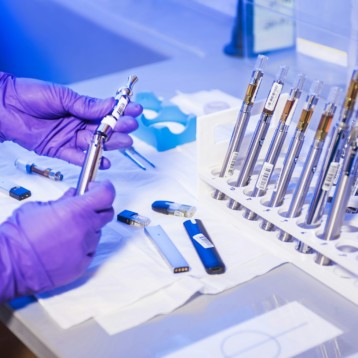Researcher Kristina Djanashvili, from Delft University of Technology in the Netherlands, has developed a new contrast agent which can be used in MRI scans in order to better identify tumors. Her discovery should lead to earlier and more precise cancer detection and treatment.
MRI (magnetic resonance imaging) is a technique which uses the magnetic properties of materials to create an image of the body section being scanned. Different sorts of tissues can be distinguished by there “color” and brightness in the final image. MRI scans are often used to identify tumors and for this purpose a contrast agent is often used. The contrast is used to increase the visibility of organs and tissues and create a more detailed image. The agent is usually injected into the patient’s vein prior to the test. Different contrast agents are used in the search for different cancer types and the quality of the image often depends on the ability of this agent to “search out” the tumor and induce contrast.
Kristina Djanashvili, a postgraduate researcher from TU Delft, has recently developed a new contrast agent with greater tumor affinity and contrast induction characteristics. Greater affinity means that a smaller amount of cancerous growth can be picked up by the MRI and tumors can be found at earlier stages and visualized more accurately than by use of existing substances. The new agent is a chemical compound that includes a lanthanide chelate and a phenylboronate group substance. The lanthanide ensures a strong, clear MRI signal and the phenylboronate group substance is the one that points out the tumor.
Lanthanide chelate influences the behavior of water molecules, and it is the behavior of the hydrogen nuclei in the water molecules that determines the quality of the MRI image. The stronger the influence of the lanthanide chelate on the neighboring hydrogen nuclei (the so-called water exchange) and the more hydrogen nuclei affected, the better the obtained MRI signal. The phenylboronate has an affinity for specific sugary molecules that usually concentrate upon cancer cell surfaces. It chemically bonds to the surface of the tumor cell and then the signal is picked up due to the lanthanide chelate’s influence on the signal intensity.
Djanashvili incorporated the compound into thermosensitive liposomes. A liposome is a tiny bubble, built from the same material as a cell membrane. They are often filled with drugs and other substances and used for an accurate drug delivery, as their membrane can interact with specific cells. A thermosensitive liposome opens up, releasing the contrast agent only when heated to 42 degrees. This means it will be possible to control the compound release using localized heating of a particular part of the body – for example the area suspected of having a tumor.
This technique has been already tested on mice with positive results, but has to undergo further research before it may be used in hospitals during routine MRI scans.
TFOT has recently covered other developments in MRI diagnosis, including microtags that can attach themselves to cancerous tissue developed at the National Institute of Standards and Technology (NIST). Another story from TFOT tells of an optical textile that can monitor patients’ state during an MRI scan, even if they are unconscious.
For more information on the new MRI contrast agent, please visit the TU Delft news page.
Top image: Liposomes (Credit:Harvard University).










